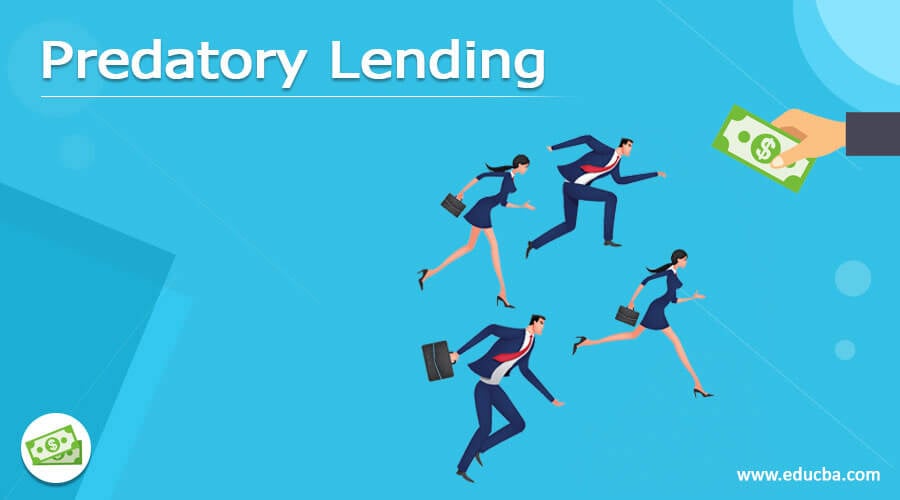Updated July 10, 2023

What is Predatory Lending?
The term “predatory lending” refers to using deceptive, unfair, or foul means to extend loans to borrowers taking advantage of their fragile situations. Predatory lending often resorts to aggressive selling tactics and leverages the borrowers’ lack of knowledge of financial instruments.
Most of these loans carry high origination fees and interest rates, often stripping borrowers of equity or pushing more creditworthy borrowers into much lower credit-rated loans.
How Does Predatory Lending Work?
Predatory lenders usually use unscrupulous practices to entice and mislead borrowers toward taking out loans that they will eventually be unable to pay back or will be paying back at an extremely high cost. These lenders lure customers through aggressive sales tactics, often e-mail, phone calls, and even door-to-door.
Predatory lenders are least bothered putting so many borrowers at risk. Typically, predatory lending targets people who suffer from inadequate income, seeking money regularly to make ends meet. Especially borrowers with low credit scores and less educated fall prey to these discriminatory lending practices.
Examples of Predatory Lending
Let us take the example of David, who was desperately looking for a mortgage loan but couldn’t qualify for the traditional one because of his outstanding debt that had put a dent in his credit score. Instead, a predatory lender contacted him and offered a mortgage loan based on the equity built into the property rather than considering his ability to repay the loan.
Since he was desperate for a loan, he took the bait and went through the process. He was unaware that this loan would allow the crooked lender to seize his equity in the home. Per the lender’s advice, he even inflated his income while applying for the loan to qualify.
He later realized that he couldn’t afford the loan’s monthly payments. Eventually, he had no other option but to default on the loan, and the lender seized the property for foreclosure. Unfortunately, David lost his home, while the lender didn’t incur any losses as the home value exceeded the outstanding loan amount at the time of default. This is a classic example of predatory lending.
Types of Predatory Lending
Predatory lending takes many different forms, and below are some of the most common types:
- Flipping Loans: In a flipping loan arrangement, the lender repeatedly refinances a high-cost loan at a slightly lower interest rate. In the process, the lender earns through loan origination fees and broker fees, while the borrower incurs losses due to prepayment penalties and closing costs.
- Balloon Payments: In this type of loan, the lender tries to sell a loan in which the payments are low initially, but a large payout becomes due at the end of its tenure. This large payment is popularly known as the balloon payment, which usually puts the borrower in a difficult financial position.
- Negative Amortization: In the case of negative amortization, the borrower pays only a certain portion of the interest cost every month while the remaining interest cost gets added to the loan balance. So, the loan balance keeps growing and hence the name.
- Payday Loans: A short-term loan becomes due on the next payday. It is one of the most dangerous forms of predatory lending owing to very high-interest rates. In a few cases, the annual percentage rate runs into three digits.
- Title loans: Another short-term and high-interest rate predatory loan backed by collateral. If the borrower fails to repay the loan in full, the lender takes possession of the asset offered as collateral.
Warning signs for Predatory Lending
The following are some of the most effective warning signs of predatory lending:
- Basic costs are unclear: Although lenders are legally mandated to disclose all their costs upfront, predatory lenders usually twist the costs or make them hard to understand or find.
- Too good to be true: These lenders often promise to help borrowers settle their debts easily, fix their already tainted credit history, or offer loans despite their pathetic credit history.
- Existing complaints against the lender: It is essential to research the lender’s background before borrowing. If there are too many bad reviews or complaints, avoiding such lenders is better.
- The lender doesn’t check creditworthiness: These lenders often don’t perform proper credit checks before lending money as they plan to pack on high-interest rates and insanely high upfront fees.
Key Takeaways
Some of the key takeaways of the article are:
- Predatory lending refers to unfair and abusive lending practices lenders use to lure borrowers into loans with high interest rates and processing fees.
- These lenders usually resort to aggressive sales tactics and deceive the borrowers into going for loans they can’t afford.
- The predatory loans target less educated and vulnerable sections of society, wherein people struggle to meet monthly expenses or have recently lost their jobs.
- Common predatory loans include flipping, balloon payments, negative amortization, payday, and title loans.
- These loans are often too good to be true, with unclear basic costs, blemished lending history, and many more.
Conclusion
So, it can be seen that predatory lending usually employs methods that are not considered illegal, but they ruin the financial position of the borrowers. Although the regulators take many steps to prevent predatory lending, it won’t be possible without widespread awareness. The borrowers must understand the predator’s actions to avoid such traps. In short, the borrowers must read all the terms and conditions of the loan agreement before signing the contract. If they don’t understand anything in the loan contracts, it is better to avoid signing them.
Recommended Articles
This is a guide to Predatory Lending. Here we also discuss the definition, working, examples, types, and warning signs of predatory lending. You may also have a look at the following articles to learn more –

